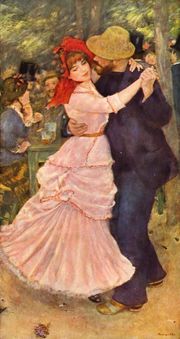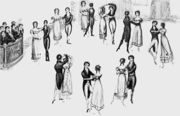Waltz
 Pierre-Auguste Renoir, Bal à Bougival, 1883 |
|
| Genre | Ballroom dance, folk dance |
|---|---|
| Time signature | 3/4 |
| Country | Austria |

The waltz is a ballroom and folk dance in 3/4 time, performed primarily in closed position.
Contents |
History
There are several references to a sliding or gliding dance,- a waltz, from the 16th century including the representations of the printer H.S. Beheim. The French philosopher Montaigne wrote of a dance he saw in 1580 in Augsburg, where the dancers held each other so closely that their faces touched. Kunz Haas, of approximately the same period wrote that, "Now they are dancing the godless, Weller or Spinner, whatever they call it."[2] "The vigorous peasant dancer, following an instinctive knowledge of the weight of fall, utilizes his surplus energy to press all his strength into the proper beat of the measure, thus intensifying his personal enjoyment in dancing".[3] The wide, wild steps of the country people became shorter and more elegant when introduced to higher society. Hans Sachs wrote of the dance in his 1568 Eygentliche Beschreibung aller Stände(1568).[2]
At the Austrian Court in Vienna in the late 17th century (1698) ladies were conducted around the room to the tune of a 2 beat measure, which then became the 3/4 of the Nach Tanz (After Dance), upon which couples got into the position for the Weller and waltzed around the room with gliding steps as in an engraving of the Wirtschaft (Inn Festival) given for Peter the Great.[4]
The peasants of Bavaria, Tyrol, and Styria began dancing a dance called Walzer, a dance for couples, around 1750. The Ländler, also known as the Schleifer, a country dance in 3/4 time, was popular in Bohemia, Austria, and Bavaria, and spread from the countryside to the suburbs of the city. While the eighteenth century upper classes continued to dance the minuet, bored noblemen slipped away to the balls of their servants.[5]
Describing life in Vienna (dated at either 1776 or 1786[6]), Don Curzio wrote, " The people were dancing mad [...] The ladies of Vienna are particularly celebrated for their grace and movements of waltzing of which they never tire." There is a waltz in the second act finale of the opera "Una Cosa Rara" written by Martin y Soler in 1786. Soler's waltz was marked Andante con moto, or "at a walking pace with motion", but the flow of the dance was sped-up in Vienna leading to the Geschwindwalzer, and the Galloppwalzer.[7][8]
In the transition from country to town, the hopping of the Ländler, a dance known as Langaus, became a sliding step, and gliding rotation replaced stamping rotation.[9]
In the 19th century the word primarily indicated that the dance was a turning one; one would "waltz" in the polka to indicate rotating rather than going straight forward without turning.
The Viennese custom is to slightly anticipate the second beat, which conveys a faster, lighter rhythm, and also breaks of the phrase. The younger Strauss would sometimes break up the one-two-three of the melody with a one-two pattern in the accompaniment along with other rhythms, maintaining the 3/4 time while causing the dancers to dance a two-step waltz. The metronome speed for a full bar varies between 60 and 70, with the waltzes of the first Strauss often played faster than those of his sons.[10]
Shocking many when it was first introduced,[11] the waltz became fashionable in Vienna around the 1780s, spreading to many other countries in the years to follow. It became fashionable in Britain during the Regency period,[12] though the entry in the Oxford English Dictionary shows that it was considered "riotous and indecent" as late as 1825. The waltz, and especially its closed position, became the example for the creation of many other ballroom dances. Subsequently, new types of waltz have developed, including many folk and several ballroom dances.
Styles
In the 19th and early 20th century, numerous different waltz forms existed, including versions performed in 2/4 or 6/8 (sauteuse), and 5/4 time (5/4 waltz, half and half)
In the 1910s, a form called the "Hesitation Waltz" was introduced by Vernon and Irene Castle.[13] It incorporated Hesitations and was danced to fast music. A Hesitation is basically a halt on the standing foot during the full waltz measure, with the moving foot suspended in the air or slowly dragged. Similar figures (Hesitation Change, Drag Hesitation, and Cross Hesitation) are incorporated in the International Standard Waltz Syllabus
The Country Western Waltz is 99% progressive, moving counter clock wise around the dance floor. Both the posture and frame are relaxed, with posture bordering on a slouch. The exaggerated hand and arm gestures of some ballroom styles are not part of this style. Couples may frequently dance in the Promenade position, depending on local preferences. Within country western waltz there are the Spanish Waltz and the more modern (for the late 1930s- early 1950s) Pursuit Waltz. At one time it was considered ill treatment for a man to make the woman walk backwards in some locations.[14]
In California the waltz was banned by Mission fathers until after 1834 because of the "closed" dance position.[15] Thereafter a Spanish Waltz was danced. This Spanish Waltz was a combination of dancing around the room in closed position, and a "formation" dance of two couples facing each other and performing a sequence of steps.[15] "Valse a Trois Temps" was the "earliest" waltz step, and the Rye Waltz was favored as a couple dance.[16]
- In contemporary ballroom dance, the fast versions of the waltz are called Viennese Waltz.
- International Standard Waltz has only closed figures; that is, the couple never breaks the embrace.
- The American Style Waltz, in contrast to the International Standard Waltz, involves breaking contact almost entirely in some figures. For example, the Syncopated Side-by-Side with Spin includes a free spin for both partners. Open rolls are another good example of an open dance figure, in which the follower alternates between the lead's left and right sides, with the lead's left or right arm (alone) providing the lead. Waltzes were the staple of many American musicals and films, including "Waltz in Swing Time" sung by Fred Astaire.
- The Cross Step Waltz is a newer style of waltz where the first step is a cross-step into the line of direction. This was popularized in classes at Stanford University and allows for a much richer assortment of variations.
- The Scandinavian Waltz. Performed as a part of Scandinavian folk dance, this can be fast or slow, but the dancers are always rotating.
- The Peruvian Waltz (Called and recognized in Peru as vals criollo).
- The Curaçaon waltz. The first composer to write Curaçaon waltzes was Jan Gerard Palm (1831–1906). Like the Strauss family in Austria, the Palm family composed numerous of popular Curaçaon waltzes. Well known composers of Curaçaon waltzes of the Palm family are Jan Gerard Palm (1831–1906), Jacobo Palm (1887–1982), Rudolph Palm (1880–1950), John Palm (1885–1925), Albert Palm (1903–1957), Edgar Palm (1905–1998) and Robert Rojer (1939). Besides the Palm family, Curaçao born composers such as Joseph Sickman Corsen, Chris Ulder, Jacobo Conrad and Wim Statius Muller are well known for their typical Curaçao waltzes.
- The Mexican Waltz (vals mexicano) follows the same basic rhythmic pattern as the standard waltz, but the melodies reflect a strong Spanish influence. Mexico's Juventino Rosas wrote "Sobre las Olas" or "Over the Waves", commonly known in the U.S. as a circus song played during a trapeze show.
- The Cajun Waltz is danced progressively around the floor, and is characterized by the subtle swaying of the hips and step very close to ordinary walking. It is danced entirely in the closed position.
- Tango vals allows the dancers to dance one, two, three, or no steps to any three beats of waltz music, and to vary the number of steps per bar throughout the song.
- The Venezuelan waltz
- The Contra Waltz (Freeform Waltz), included in most contra dance evenings, uses both open and closed positions, and incorporates moves from other dances such as swing, modern jive and salsa. Basically the dancers progress around the dance floor with a waltz step, but with no constraints on what moves they can use.
See also
- Austrian folk dancing
- Waltz (music)
- Usul (music)
References
- ↑ 1.0 1.1 Blatter, Alfred (2007). Revisiting music theory: a guide to the practice, p.28. ISBN 0415974402.
- ↑ 2.0 2.1 Nettl, Paul. Birth of the Waltz, in Dance Index vol 5, no. 9. 1946 New York: Dance Index-Ballet Caravan, Inc. page 211
- ↑ The Birth of the Waltz. Nettl, Paul. in Dance Index vol 5, no. 9. 1946 New York: Dance Index-Ballet Caravan, Inc. page 211
- ↑ Nettl, Paul. Birth of the Waltz, in Dance Index vol 5, no. 9. 1946 New York: Dance Index-Ballet Caravan, Inc. pages 208, 211
- ↑ A Dictionary of Music and Musicians (A.D. 1450–1880) By George Grove, Sir George Grove, John Alexander Fuller-Maitland, Adela Harriet Sophia (Bagot) Wodehouse. Published 1889. Macmillan
- ↑ Johann Strauss: Father and Son a Century of Light Music By H. E. Jacob. By H. E. Jacob. 2005. page 24 ISBN 1417993111
- ↑ The Waltz Emperors. Wechsberg. 1973. C. Tinling & Company. page 49, 50)
- ↑ A Dictionary of Music and Musicians (A.D. 1450–1880) By George Grove, Sir George Grove, John Alexander Fuller-Maitland, Adela Harriet Sophia (Bagot) Wodehouse. Published 1889. Macmillan. page 385
- ↑ Johann Strauss: Father and Son a Century of Light Music By H. E. Jacob. By H. E. Jacob. 2005. page 25 ISBN 1417993111
- ↑ The Waltz Emperors. Wechsberg. 1973. C. Tinling & Company. pages 59–61
- ↑ Mozart: A Cultural Biography By Robert W. Gutman. 1999. Harcourt. Pages 44–45
- ↑ Boyd Hilton, A Mad, Bad, and Dangerous People? England 1783–1846 (Oxford U P 2006).
- ↑ "The History of Ballroom/Partnership Dance in America". http://www.danceintimeproductions.com/history.htm. Retrieved 2007-07-03.
- ↑ Cowboy Dances. Lloyd Shaw. 1939-1952. The Caxton Printers. pages 101-103. no ISBN
- ↑ 15.0 15.1 Dances of Early California Days. Lucile K. Czarnoski. 1950. Pacific Books. page 44.
- ↑ Dances of Early California Days. Lucile K. Czarnoski. 1950. Pacific Books. page 121.
External links
- Basic Steps of Waltz Dance
- Waltz video example
- The Waltz Dance Steps & Moves
- Music regarding: Waltz within traditional dances of the County of Nice (France)
- Scroll to "Five Step Waltz" for notes about probable 1847 origin and associated music published the same year.
- Halman, Johannes and Robert Rojer (2008). Jan Gerard Palm Music Scores: Waltzes, Mazurkas, Danzas, Tumbas, Polkas, Marches, Fantasies, Serenades, a Galop and Music Composed for Services in the Synagogue and the Lodge. Amsterdam: Broekmans and Van Poppel.*[1]
- Thomas Wilson's 1816 Waltz Manual
|
||||||||||||||
|
||||||||